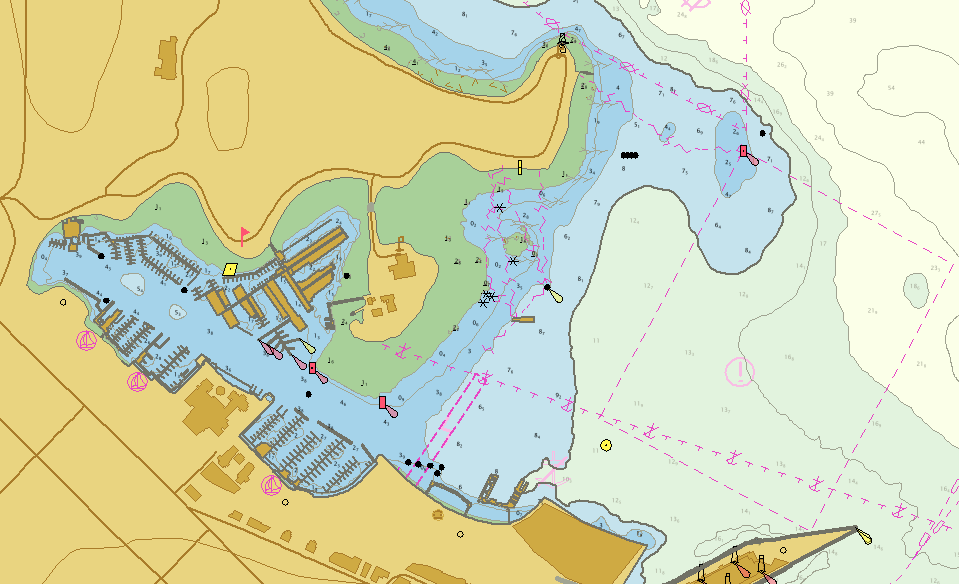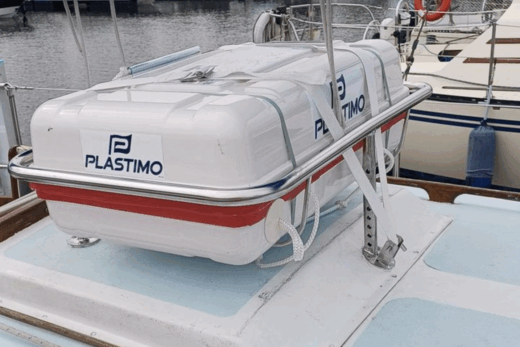
This post provides a brief update on Fisheries and Ocean’s 2016 report on the carryage requirement for paper charts. It simultaneously clarifies the state of legislation and the Governement of Canada’s intention regarding the obligation to carry paper charts on pleasure crafts. It further examines the requirements in the UK, France, Germany, the USA, and looks at what the International Maritime Organization (IMO) is saying. The focus is on sailboats and charts. It is therefore preferable to consult other references to assess obligations for other types of craft, or for other obligations.
International Maritime Organization
The SOLAS Convention, Chapter V, Regulation 19, requires all ships to carry navigational charts (IMO, 2002). An Electronic Chart Display and Information System (ECDIS) is an acceptable substitute. An ECDIS is not just any electronic navigation system, but must comply with IMO Resolution A817(10), which specifies a need for redundancy and power supply independent of the current power supply system (IMO, 1995). In other words, a typical sailboat onboard computer does not meet the definition of an ECDIS. Consequently, the paper chart requirement applies where IMO jurisdiction applies.
IMO has jurisdiction only through the ratification of treaties and conventions by member countries. Thus, the SOLAS convention must be examined through the laws in a specific jurisdiction, including any exceptions. In laymens terms, SOLAS applies when the law of a country says it applies.
Canada
Current Legislation
Article 103 of the Safety of Navigation Regulations 2020 states that pleasure crafts are not subject to the SOLAS Convention (Ministry of Justice, 2020). The same regulations, however, specify in articles 142 and 143 that vessels must comply to similar provisions regarding paper charts (id. 2020), i.e. to have up-to-date and adequate charts on board (as well as the list of lights, notices to mariners, etc.). Article 142 grants an exception for ships with a gross tonnage of less than 100 tonnes (!):
[…] if the person in charge of navigation has sufficient knowledge of the following about where the vessel is to be navigated such that the safety and efficiency of navigation in that area will not be compromised:
Safety of Navigation Regulations 2020 (art. 142)
- (a) the location and character of charted
- (i) shipping routes,
- (ii) lights, buoys and marks, and
- (iii) navigational hazards; and
- (b) the prevailing navigational conditions, taking into account such factors as tides, currents, and ice and weather patterns.
In his article on the future of paper charts in Canada, Bunzel points out that an on-board computer used for navigation (Navionics, OpenCPN, etc.) could very well be interpreted by “sufficient local knowledge” (Bunzel, n.d.). Of course, this is just his interpretation!
There are other exceptions in the regulation, notably if maps of the navigated area do not exist. Article 143 includes the definition of an ECDIS and the statement that it is a substitute for a paper chart.
Intention
To my knowledge, there is no government document attesting to the Government of Canada’s intention to amend the obligations specified in the regulation. However, the Canadian Hydrographic Service is actively digitizing its charts and aims to complete its transformation within five years (CHS, 2022). The last modification to the web page was in 2022, so the five-year timetable leas to 2027 at the latest. The web page does, however, promote the electronic material and provides several ways in which a “user” can obtain it.
United States
Current Legislation
The National Oceanic and Atmospheric Administration (NOAA) presents a summary page on chart carriage requirements in the United States (NOAA, n.d.). In particular, Title 46 of the Code of Federal Laws states in section 26.03-4 that “every vessel shall have adequate, current, and appropriately scaled charts for safe navigation” (Electronic Code of Federal Regulations, 2023). The law is therefore no different from the SOLAS Convention. However, its interpretation by the U.S. administration is different.
Intention
Directive NVIC-01-16, issued jointly by the US Coast Guard and Homeland Security, stipulates that for inspection purposes, electronic charts are assimilated to paper charts for the purposes of carriage requirements (United States Coast Guard and Department of Homeland Security, 2016). The US position is therefore different in its interpretation: electronic charts are deemed equivalent to paper charts.
United Kingdom
Current Legislation
The UK Coastguard provides a compendium of the various legislation applicable to pleasure craft under 24 meters in its Maritime Guidance Note 280 M (Maritime and Coastguard Agency, 2004). Article 19.1 refers to paper chart requirements. In essence, the obligations are the same as in Canada, i.e. a vessel should carry charts unless there is a clear knowledge of the area (id., 2004).
Intention
The United Kingdom Hydrographic Office (UKHO) has announced its intention to cease paper chart production by 2030 (UKHO, n.d.). Their posture is committed to migration to electronics by pushing for consistent international regulations:
The move to digital charting throughout for all types and sizes of vessels is undeniable. […] By its nature, much of commercial and leisure navigation is international and the UKHO believes that an international approach is the right course to take. We have therefore commenced an international effort to tackle the lack of cohesive regulations for digital navigation for vessels that operate with a reliance on paper charts to meet current regulations.
UKHO (n.d.)
Stickland (2023) reports that the government’s intention is to have onboard computers approved as substitutes for paper charts by 2030 (Stickland, 2023).
France
State of Legislation
French legislation seems to allow navigation without paper charts. In the report from the International Hydrographic Organization, the French government states that “no legislative changes are required [to allow navigation with electronic charts], as navigation without a chart is already permitted” (International Hydrographic Organization, 2020). Further sources from the French government would be welcome to reinforce this interpretation.
Australia
State of Legislation
Section 224 of Australian law states that it is an offense not to have charts on board, specifying that electronic charts satisfy the definition of “chart” (Government of Australia, 2012). This means that a ship with electronic charts onboard does not contravene the law. This interpretation is also confirmed by the Australian Government Hydrographic Office (Australian Hydrographic Office, n.d.). As long as the electronic charts are those produced by the Australian Government, pleasure craft will be deemed to comply with the country’s laws and regulations.
Conclusion
In essence, the countries analyzed have already migrated, or are in the process of migrating, to paperless navigation. The UK is leading the international coordination charge. Paperless navigation is a reality in the USA and Australia, and appears to be the case in France too. The UK intends to join the group by 2030, while Canada has no clear plans. As Bunzel (n.d.) points out, inspection efforts in this area are very thin on the ground. Perhaps this is Canada’s implicit strategy: a laissez-faire approach that will eventually change legislative interpretation, as the United States has done.
References
Australian Hydrographic Office (s.d.). Electronic Charting Information, web page retrieved online in september 2023 from this url.
Bunzel, M. (s.d.). The Future of Paper Charts, Canadian Yachting, web page retrieved online in september 2023 this url.
Electronic Code of Federal Regulations (2023). Title 46: Shipping, document retrieved online in september 2023 from this url.
Gouvernement de l’Australie (2012). Navigation Act 2012, No. 128, 2012: An Act relating to maritime safety and the prevention of pollution of the marine environment, and for related purposes, document retrieved online in september 2023 from this url.
International Hydrographic Organization (2020). The Future of the Paper Nautical Chart: Final Report, document retrieved online in september 2023 from this url.
International Maritime Organization (s.d.). Hydrographic Data, Nautical Charts and Nautical Publications, web page retrieved online in september 2023 à this url.
id. (2002). SOLAS Chapter V – 1/7/02: Safety of Navigation, document retrieved online in september 2023 from this url.
id. (1995). Resolution A817(19): Performance Standards for Electronic Chart Display and Information Systems (ECDIS), document retrieved online in september 2023 from this url.
Maritime and Coastguard Agency (2004). Small Vessels in Commercial Use for Sport or Pleasure, Workboats and Pilot Boats – Alternative Construction Standards, document retrieved online in september 2023 from this url.
Ministère de la Justice (2020). Règlement de 2020 sur la sécurité de la navigation DORS/2020-216, document retrieved online in september 2023 from this url.
National Oceanic and Atmospheric Administration (s.d.). Chart Carriage Requirements, web page retrieved online in september 2023 at this url.
Service Hydropgraphique Canadien (2022). Transformation numérique au SHC, document retrieved online in september 2023 from this url.
Stickland, K. (2023). Withdrawal of Admiralty paper charts delayed until 2030, Practical Boat Owner, document retrieved online in september 2023 from this url.
United Kingdom Hydrographic Office (s.d.). The UKHO supports regulation of digital charting for vessels sailing without dual ECDIS, document retrieved online in september 2023 from this url.
United States Coast Guard and U.S. Department of Homeland Security (2016). Navigation and Vessel Inspection Circular No. 01-16: Use of Electronic Charts and Publications In Lieu of Paper Charts, Maps and Publications, document retrieved online in september 2023 from this url.



